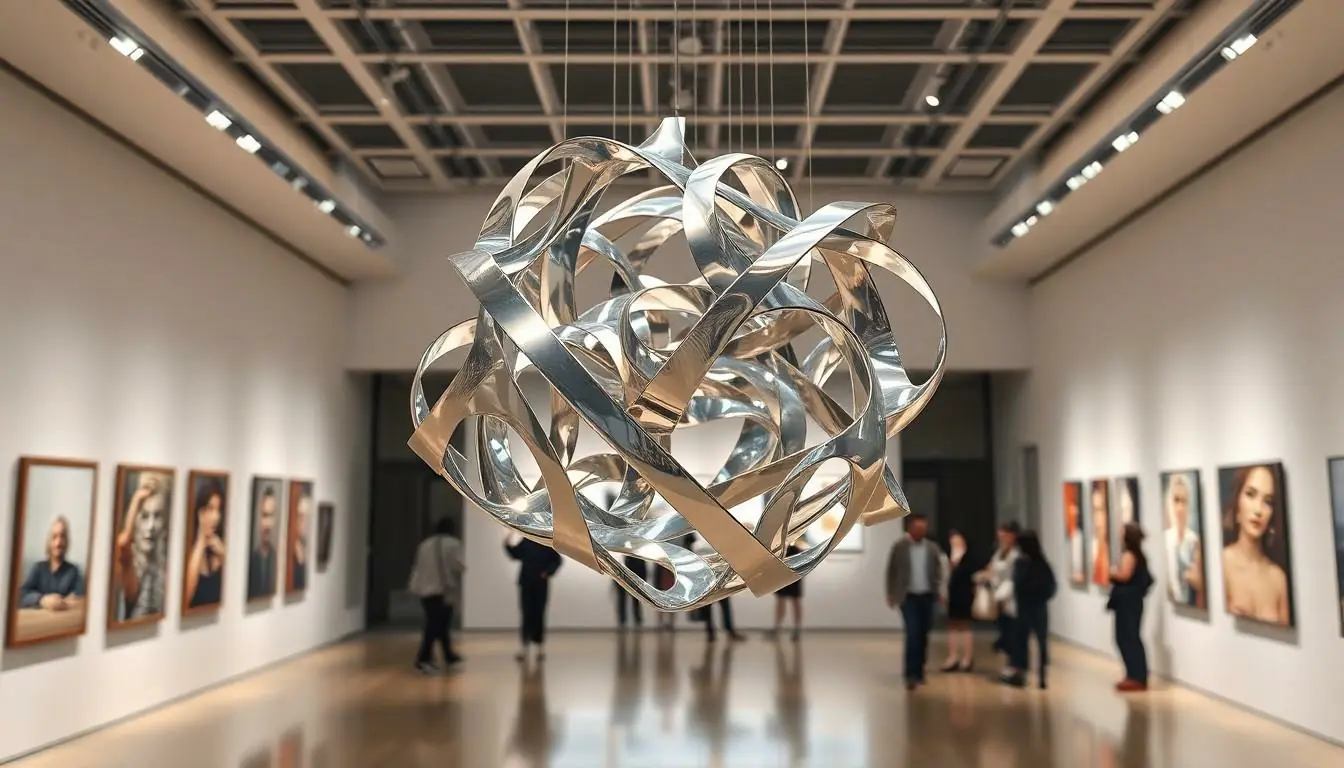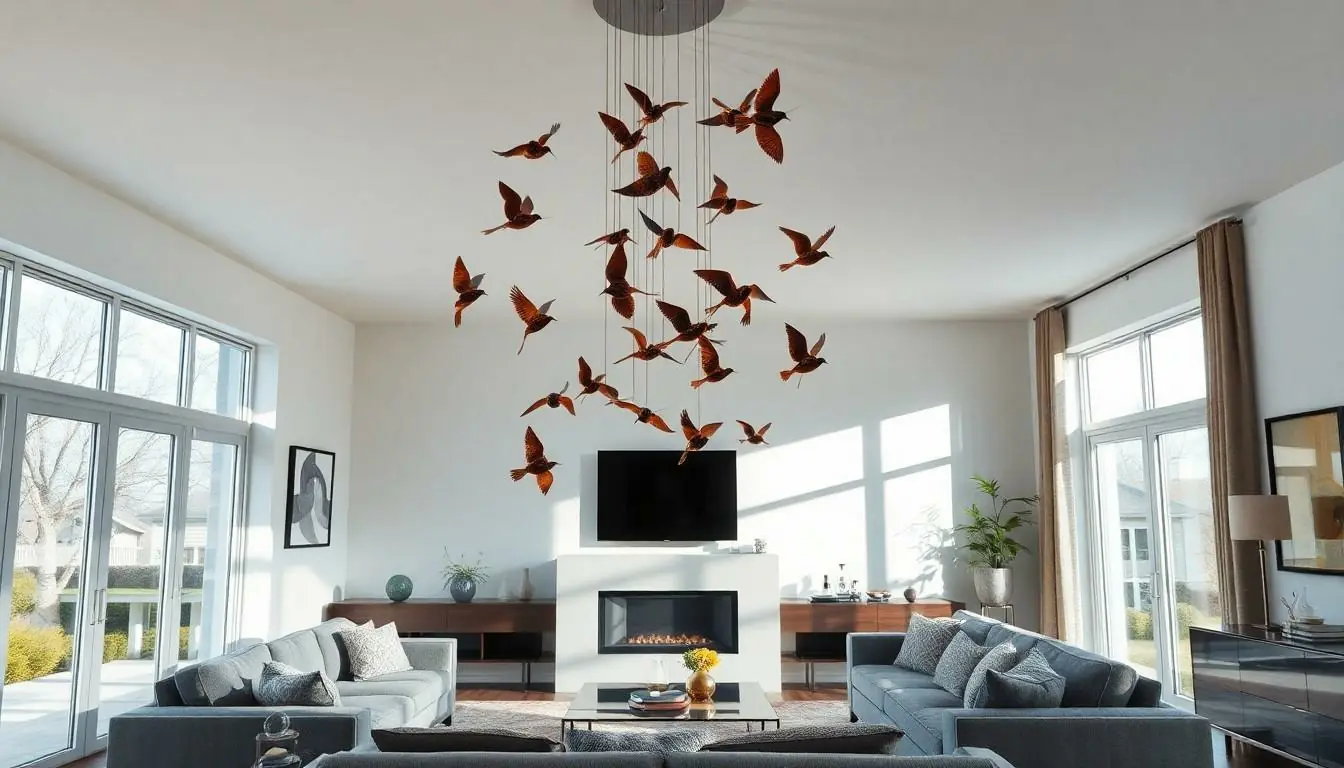Table of Contents
ToggleImagine walking into a room and being greeted by a stunning piece of art that seems to float effortlessly in mid-air. Hanging sculptures have a magical way of transforming ordinary spaces into extraordinary experiences. They’re not just decorations; they’re conversation starters, mood enhancers, and sometimes even gravity-defying feats of creativity.
In a world where wall art reigns supreme, hanging sculptures bring a fresh twist to interior design. Whether it’s a whimsical bird made of metal or an elegant glass orb, these pieces invite curiosity and admiration. So why settle for the same old framed pictures when you can add a touch of three-dimensional flair to your life? Dive into the world of hanging sculptures and discover how they can elevate your space from mundane to magnificent.
Overview of Hanging Sculpture
Hanging sculptures enhance spaces by adding depth and dimension to interior design. These art pieces draw attention, often serving as focal points that invite discussion. Diverse materials such as metal, glass, and wood contribute to the wide range of designs available.
Artists create innovative forms, resulting in unique visual experiences. Those who appreciate contemporary aesthetics often favor abstract shapes, while others may opt for figurative representations. Versatile in nature, hanging sculptures adapt to various styles, from rustic to modern.
Designers frequently incorporate these sculptures in different environments. Living rooms benefit from whimsical pieces that ignite imagination. Conversely, more minimalist designs suit professional settings like offices or galleries. These artworks engage viewers at different levels, stimulating creative thought.
Installation options vary and include ceiling mounts, wall brackets, or suspended cables. Proper placement enhances the sculpture’s effect, allowing light to play off its surfaces and create dynamic shadows. Ensuring adequate space around each piece promotes visual comfort and accessibility.
Incorporating hanging sculptures into home decor encourages individuality. They offer homeowners a chance to express personal style while enhancing ambience. By selecting unique pieces, individuals can craft an inviting and inspiring atmosphere that reflects their tastes.
History of Hanging Sculpture

Hanging sculptures trace their roots to ancient civilizations, showcasing humanity’s enduring fascination with suspended art forms.
Ancient Practices
Ancient cultures used hanging sculptures in religious practices and ritualistic ceremonies. Egyptians suspended effigies from ceilings and temples, symbolizing divine presence. Similarly, the Aztecs crafted mobile sculptures made from precious materials, celebrating their deities. Ancient Greeks also embraced this form of art, often using hanging elements in architecture and monuments to convey harmony and balance. These early practices highlight how humans have historically sought to merge art with spirituality and community.
Modern Interpretations
Contemporary artists revamped hanging sculptures, introducing innovative materials and techniques. Modern interpretations span from large-scale installations to delicate, intricate designs, often featured in galleries and public spaces. Artists frequently blend technology with traditional crafting methods, resulting in dynamic artworks that respond to light and movement. Minimalist styles dominate current trends, with sleek forms that complement modern interiors. Designers continue to experiment with scale and perspective, ensuring hanging sculptures captivate audiences and transform environments.
Techniques Used in Hanging Sculpture
Hanging sculptures employ various techniques that enhance their visual and structural appeal. Artists select specific materials and tools to create unique designs.
Materials and Tools
Metal, glass, and wood dominate the construction of hanging sculptures. Metals such as stainless steel and aluminum provide durability and can withstand outdoor conditions. Glass offers elegance and lightness, often used in intricate, colorful designs. Wood brings warmth and natural beauty, with many selecting reclaimed pieces for sustainability. Tools vary from welding equipment for metal joining to glass-blowing kits for crafting stunning glass pieces. Each material and tool contributes to a sculpture’s character, leaving a lasting impression.
Methods of Suspension
Suspension methods impact the visual experience of hanging sculptures. Varying techniques include cables and chains for a contemporary look, allowing sculptures to sway gently. Brackets and hooks provide stability while enhancing the aesthetic, enabling artworks to appear as if they float. Monofilament lines create an illusion of gravity-defying art by allowing maximum visibility. Each method is carefully chosen to amplify the sculpture’s presence, making it an engaging focal point.
Notable Artists in Hanging Sculpture
Hanging sculptures feature a variety of artists who contribute significantly to the art form. Their works span both contemporary and historical contexts, showcasing diverse styles and techniques.
Contemporary Artists
Contemporary artists such as Ann Hamilton and David Choe create compelling hanging sculptures that engage audiences. Hamilton’s installations often incorporate sound and light, adding an immersive layer to her suspended pieces. Choe utilizes vibrant colors and dynamic forms, making his artworks pop in any environment. Another notable figure, Yoko Ono, blends conceptual art with hanging elements, inviting viewers to interact with her installations. These artists help redefine hanging sculpture, merging traditional practices with modern sensibilities.
Influential Historical Figures
Influential historical figures, including Alexander Calder and Joan Miró, laid the groundwork for hanging sculpture. Calder pioneered the mobile, transforming kinetic art through delicate balance and movement. His innovative designs introduced motion as a critical component. Miró embraced surrealism, with suspended works that challenged perceptions of space and form. Artists like these shaped the evolution of hanging sculpture, inspiring future generations through their creativity. Their legacies continue to resonate in contemporary practices, illustrating the enduring impact of their artistic visions.
Hanging sculptures stand out as a dynamic addition to any interior space. They not only elevate aesthetics but also encourage personal expression and creativity. By thoughtfully selecting materials and designs, homeowners can create unique atmospheres that resonate with their individual styles.
The rich history and evolution of hanging sculptures reflect their enduring appeal and versatility. As contemporary artists continue to innovate within this art form, the potential for transformation in home decor remains limitless. Whether it’s a whimsical piece or a minimalist design, incorporating hanging sculptures can truly redefine a space and spark meaningful conversations.




